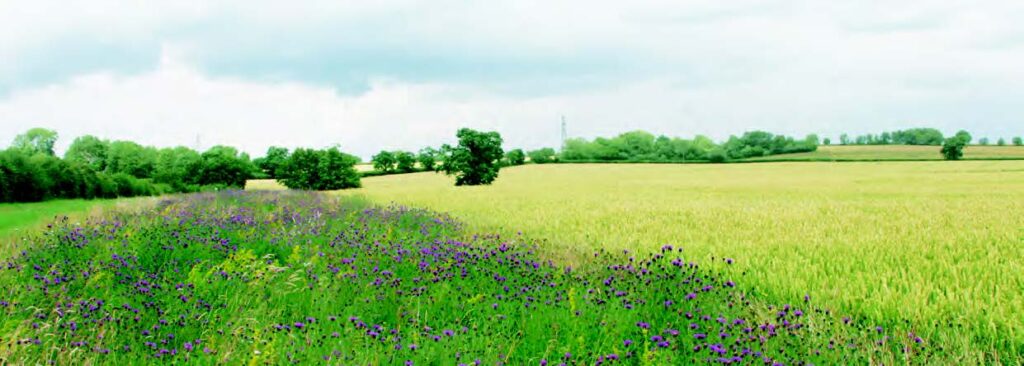
Whilst the new Sustainable Farming Incentive (SFI) rules are complex and confusing in parts, taking a step-by-step approach to their application can help growers get the most out of them in the least time, says independent farm business consultant Paul Pickford.
There is little doubt that DEFRA have succeeded in achieving one of their main objectives for the new SFI application service which is to make it quicker and more straightforward for farmers, but it’s still a daunting task for many.
Look below the surface and you will also see there’s much more flexibility built-in as to how you implement the rules and manage them subsequently, so it should be a less demanding process to manage over the years.
With 2027 being the last payment under the old BPS scheme, it’s important producers understand as much as possible about what SFI offers and how they can make it work as effectively as possible in their business.
This, of course, is much easier said than done. Much of the detail is still evolving with changes being introduced alongside ongoing discussions about how existing schemes will align with the new one, not to mention further options being introduced in future years.
Nonetheless, and regardless of the precise detail of the final scheme, a good starting point for many applicants will be to break down the application process into three distinct stages.
| STAGE 1 – FOCUS ON THE EASY WINS |
| STAGE 2 – TAKE ADVANTAGE OF THE OBVIOUS AREAS |
| STAGE 3 – TIME TO DO SOME HOMEWORK |
As the name implies, the first of these is to take advantage of the ‘easy wins’ by simply making sure you apply for all the things that you are already doing.
The next involves the obvious areas, bits of fields or whole fields, where you can change land management practices in line with SFI requirements and payments, without causing too much disruption to the farm overall.
The final stage is to spend a bit more time identifying other areas where you can make SFI gains but that might involve analysis of field records and historical yield data to make sure you are making the right decisions.
Where you will make the biggest wins will depend on the size of your farm. With some of the stage one ‘easy wins’ being based on single payments regardless of area involved, smaller farms will benefit from these disproportionately relative to larger businesses.
Where bigger enterprises might really win out, by contrast, is in stages two and three when they start making changes to farming and land management practices to leverage payments made per ha of land involved. The table below explains this.
| STAGE | 200 ha arable farm | 600 ha arable farm |
|---|---|---|
| STAGE 1 – FOCUS ON THE EASY WINS | 25% | 15% |
| STAGE 2 – TAKE ADVANTAGE OF THE OBVIOUS AREAS | 5% | 7.5% |
| STAGE 3 – TIME TO DO SOME HOMEWORK | 5% | 7.5% |
An effective approach could be to take your stage one ‘easy wins’ first and some of the stage two ‘obvious areas’ alongside this. This could be a realistic, and sufficient, year one target in many circumstances.
You then have time to look at the final areas in greater detail and add them to SFI in subsequent years.

Adopting a step by step process will ensure you’re making the biggest gains from the effort you put in and give you options as to how far you want to take it in terms of optimising all possibilities from the scheme
For more information, please contact the environmental team at info@agrii.co.uk
| STAGE 1 – FOCUS ON THE EASY WINS |
|---|
| So what are the areas and business practices you should act on first – the things you are already doing. Well, to net £5.80/ha all you have to do is test your soil organic matter and prepare a soil management plan on the nature of your soils and the risks they might be exposed to in the future. Most farmers are doing this to an extent anyway as part of the Red Tractor scheme and would also have carried it out under cross compliance, so it should be quite an easy task to complete. Once you have done this, you also get access to a management payment of £20/ha for the first 50 ha of your land. Then you can look at hedgerows. Making an assessment of your hedgerows, size width, height etc., will pay you £3 for every 100m. You can then manage these pretty much how you want to from there. You can cut them every year, as long as you cut them a little higher (incremental cutting), or you can do this every second or third year. Many farmers already cut their hedgerows every other year anyway, so the £13 per 100m on offer for this is a very definite easy win. On the same theme is the single one-off payment of £989 available under SFI for completing an Integrated Pest Management (IPM) plan. Most farmers will be doing this anyway as part of Red Tractor. Again, similar for the nutrient management plan and, whether under the NVZ rules or the farming rules for water, everybody should already have one of these and it’s worth £589 under SFI. Between management, IPM and nutrient management plans, there’s just under £2,600 on offer within the scheme and that’s a good start. There are also some elements which have been re-introduced from ELS such as the arable field corners scheme and these are worth thinking about. Where farmers used to swing around and back in and do the whole field, ELS encouraged them to leave the corner and that’s now paying £590 for every ha of land left in this way under the new SFI. On some farms, the buffer strips that were put in under ELS are still there and again these will attract payments, as will creating new ones. On an arable field, you’ll get £451/ha for having a buffer strip. A lot of farmers are now planting multi-species cover crops and if you are one of them, there is a payment of £129/ha available. A companion crop will pay you £55/ha and crops that have no insecticide use will get another £45/ha. When you consider there are no insecticides available for use in spring barley and increasing numbers of OSR growers no longer bother with them and use buckwheat as a companion crop, that’s money many growers can easily attain. Because many of these payments are rotational options, you can do a calculation that says in the first year, for example, I am going to have 40 ha of no insecticide use land on the farm but in year two, my area of spring barley is going to be 60 ha. That’s fine – you’ll get paid for the 60 ha of no insecticide in your spring barley and provided your area remains above 50% of the original application in years two and three that is also acceptable. It’s a good example of how the rules are less prescriptive than previously. The main driver now is that key activities actually happen in the first place rather than the government wanting to micro-manage them once they are there. The fact that the SFI scheme lasts three years now instead of five, also makes it much more flexible, too. |
| STAGE 2 – TAKE ADVANTAGE OF THE OBVIOUS AREAS |
|---|
| If you are going to put in new corners and buffer strips, for example, you will be taking land out of production and this is where things get a little more complicated and where stage two comes in. You’ll need to think carefully about what you are doing and why. Ultimately, it’s about identifying the parts of the farm that aren’t profitable when it comes to cropping and could benefit more from being in SFI. Many of us have grown up in an era where you crop the field from edge to edge as much as you can and that is what farming has really been all about. But, without BPS or other support to fall back on, we actually have to look at fields differently and understand which of them, and what parts of them, make the most money. If the average yield of a particular field is 10 or 11 t/ha, then it’s obviously making some good money, but there will be parts of that field, whether it’s a boggy corner or a shady bit under a hedge, that might only be doing 5 t/ha. If it is only doing 5 t/ha and you are spending the same money on inputs costs and fuel and labour etc., you’re actually losing money on that portion of the field. Choosing to grow a pollinator mix, wildflowers or some winter bird food on that particular piece of land could not only make a more positive contribution to the environment, it would make you more money. Those three options will all make a gross margin of somewhere just over £500/ha which could be considerably more than you would have earned by growing 5 t/ha of wheat. |
| STAGE 3 – TIME TO DO SOME HOMEWORK |
|---|
| In many cases, growers will know exactly where their least productive areas are but in some instances this may need a bit more investigation. The bad bits are obvious, but the more marginal areas will need a bit more work to identify. If an area has always produced 4-5 t/ha that’s a given. But if it produces 7 t/ha in most years and a bit more in some, that’s a harder call. Although the new SFI scheme is a simpler and easier scheme for farmers to get in to, it does require thought and planning to get the most out of it. Being a three year scheme, unlike the old stewardship schemes which were five years, does mean that if you get something wrong it is not the end of the world, but it’s far better to put the effort in to get the best out of it from the beginning. Some of the benefits from looking at the finer detail may only be small, but at the end of the day it is the aggregation of these improvements that will make all the difference. Take the case of headlands for example. It could be that you have turned on two particular headlands for many years without really appreciating the implications of this. Looking at yield information from the last 3-5 years could tell you yields are down 15% in these areas, probably as a result of compaction, and a quick calculation can reveal exactly what that is costing in money terms. It could be that a better result can be achieved through planting some wildflowers (e.g. IPM2 or AHL1) and using that as a turning headland. At the end of the day, it’s about how creative you can be, within the rules of the scheme, and how much time you want to put into this. Some people are very thorough when it comes to making these sorts of things work and others less so. The last thing you want to be doing is replacing profitable cropping with game cover, for example, through a lack of imagination and information or simply time to evaluate the situation properly. |


